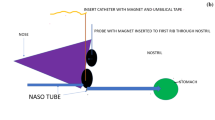Abstract
Background
The contemporary management of children with ileocolic intussusception often includes pneumatic reduction. While failure of the procedure or recurrence after reduction can result in the need for surgical treatment, more serious adverse sequelae can occur including perforation and, rarely, tension pneumoperitoneum. During the last year, four cases of perforation during attempted pneumatic reductions complicated by tense pneumoperitoneum have occurred in our center.
Objective
We have elected to report our patient experience, describe methods of management and review available literature on this uncommon but serious complication.
Materials and methods
Using ICD-9 diagnosis codes, we reviewed the records of children with intussusception during 2011. Demographic and therapeutic clinical data were collected and summarized.
Results
During the study period, 101 children with intussusception were treated at our institution, with 19% (19/101) of them requiring surgical intervention. Four children (4%) experienced a tense pneumoperitoneum during air enema reduction, prompting urgent needle decompression in the fluoroscopy suite. These children required bowel resection during subsequent laparotomy. No deaths occurred.
Conclusion
Pneumoperitoneum is a real and life-threatening complication of pneumatic enemas. It requires immediate intervention and definitive surgical management. Caution should be exercised by practitioners performing this procedure at institutions where pediatric radiology experience is limited and immediate pediatric surgical support is not available.


Similar content being viewed by others
References
Parashar UD, Holman RC, Cummings KC et al (2000) Trends in intussusception-associated hospitalizations and deaths among US infants. Pediatrics 106:1413–1421
Pracros JP, Tran-Minh VA, Morin de Finfe CH et al (1987) Acute intestinal intussusception in children. Contribution of ultrasonography (145 cases). Ann Radiol 30:525–530
Daneman A, Alton DJ, Ein S et al (1995) Perforation during attempted intussusception reduction in children – a comparison of perforation with barium and air. Pediatr Radiol 25:81–88
Gu L, Alton DJ, Daneman A et al (1988) John Caffey Award. Intussusception reduction in children by rectal insufflation of air. AJR Am J Roentgenol 150:1345–1348
Daneman A, Navarro O (2004) Intussusception. Part 2: an update on the evolution of management. Pediatr Radiol 34:97–108, quiz 187
Samad L, Marven S, El Bashir H et al (2012) Prospective surveillance study of the management of intussusception in UK and Irish infants. Br J Surg 99:411–415
Tareen F, Ryan S, Avanzini S et al (2011) Does the length of the history influence the outcome of pneumatic reduction of intussusception in children? Pediatr Surg Int 27:587–589
Kaiser AD, Applegate KE, Ladd AP (2007) Current success in the treatment of intussusception in children. Surgery 142:469–475, discussion 475–477
Hadidi AT, El Shal N (1999) Childhood intussusception: a comparative study of nonsurgical management. J Pediatr Surg 34:304–307
Chiapponi C, Stocker U, Korner M et al (2011) Emergency percutaneous needle decompression for tension pneumoperitoneum. BMC Gastroenterol 11:48
Kealey WD, McCallion WA, Boston VE (1996) Tension pneumoperitoneum: a potentially life-threatening complication of percutaneous endoscopic gastrojejunostomy. J Pediatr Gastroenterol Nutr 22:334–335
Ng E, Kim HB, Lillehei CW et al (2002) Life threatening tension pneumoperitoneum from intestinal perforation during air reduction of intussusception. Paediatr Anaesth 12:798–800
Stein M, Alton DJ, Daneman A (1992) Pneumatic reduction of intussusception: 5-year experience. Radiology 183:681–684
Yoon CH, Kim HJ, Goo HW (2001) Intussusception in children: US-guided pneumatic reduction – initial experience. Radiology 218:85–88
Curtis JL, Gutierrez IM, Kirk SR et al (2010) Failure of enema reduction for ileocolic intussusception at a referring hospital does not preclude repeat attempts at a children’s hospital. J Pediatr Surg 45:1178–1181
Jen HC, Shew SB (2009) The impact of hospital type and experience on the operative utilization in pediatric intussusception: a nationwide study. J Pediatr Surg 44:241–246
Ramachandran P, Gupta A, Vincent P et al (2008) Air enema for intussusception: is predicting the outcome important? Pediatr Surg Int 24:311–313
Saxena AK, Hollwarth ME (2007) Factors influencing management and comparison of outcomes in paediatric intussusceptions. Acta Paediatr 96:1199–1202
Navarro OM, Daneman A, Chae A (2004) Intussusception: the use of delayed, repeated reduction attempts and the management of intussusceptions due to pathologic lead points in pediatric patients. AJR Am J Roentgenol 182:1169–1176
Maoate K, Beasley SW (1998) Perforation during gas reduction of intussusception. Pediatr Surg Int 14:168–170
Bramson RT, Blickman JG (1992) Perforation during hydrostatic reduction of intussusception: proposed mechanism and review of the literature. J Pediatr Surg 27:589–591
Okazaki T, Ogasawara Y, Nakazawa N et al (2006) Reduction of intussusception in infants by a pediatric surgical team: improvement in safety and outcome. Pediatr Surg Int 22:897–900
Conflicts of interest
We have no conflicts of interest to declare.
Author information
Authors and Affiliations
Corresponding author
Rights and permissions
About this article
Cite this article
Fallon, S.C., Kim, E.S., Naik-Mathuria, B.J. et al. Needle decompression to avoid tension pneumoperitoneum and hemodynamic compromise after pneumatic reduction of pediatric intussusception. Pediatr Radiol 43, 662–667 (2013). https://doi.org/10.1007/s00247-012-2604-y
Received:
Revised:
Accepted:
Published:
Issue Date:
DOI: https://doi.org/10.1007/s00247-012-2604-y




